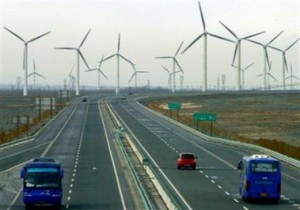Japan has approved incentives for renewable energy that could unleash billions of dollars in clean-energy investment and help the world’s third-biggest economy shift away from a reliance on nuclear power after the Fukushima disaster.
Industry Minister Yukio Edano approved the introduction of feed-in tariffs (FIT), which means higher rates will be paid for renewable energy. The move could expand revenue from renewable generation and related equipment to more than $30 Bn by 2016, brokerage CLSA estimates.
The subsidies from July 1 are one of the few certainties in Japan’s energy landscape, where the government has gone back to the drawing board to write a power policy after the Fukushima radiation crisis, the world’s worst nuclear disaster since Chernobyl in 1986.
The push for renewables is aimed at cutting reliance on not only nuclear, but pricey oil and liquefied natural gas for energy needs.
The scheme requires Japanese utilities to buy electricity from renewable sources such as solar, wind and geothermal at pre-set premiums for up to 20 years. Costs will be passed on to consumers through higher bills.
Utilities will pay 42 yen (53 U.S. cents) per kilowatt hour (kwh) for solar-generated electricity, double the tariff offered in Germany and more than three times that paid in China.
Wind power will be subsidized at least 23.1 yen per kwh, compared with as low as 4.87 euro cents (6 U.S. cents) in Germany.
Subsidies have spurred explosive growth in renewable energy in countries such as Germany, which has nearly tripled its output in less than a decade.
Still, Japan’s aim to accelerate investment in safer, cleaner and self-sufficient energy is starting from a low base: renewable sources apart from large hydro-electric dams account for only 1% of power supply in Japan.
Nuclear power accounted for almost 30% of Japan’s electricity supply before an earthquake and tsunami on March 11 last year triggered the Fukushima disaster.
About 60% came from oil, coal and gas, but that share has risen to almost 90% as safety concerns led to all of Japan’s 50 reactors being shut. The rest of Japan’s electricity comes mostly from hydro.
The government estimates capacity from renewable energy will increase to 22,000 megawatts by the end of March 2013, up from 19,500 MW now, with 2,000 MW of that from solar panels.
But Japan has huge potential to generate renewable energy from the sun, wind and geothermal, analysts say.
CLSA Asia-Pacific predicts solar capacity will jump to about 19 gigawatts by 2016 from about 5 GW or less now, while wind capacity may reach 7.6 GW in four years.
![Japan approves renewable subsidies Japan has approved incentives for renewable energy that could unleash billions of dollars in clean-energy investment and help the world’s third-biggest economy shift away from a reliance on nuclear power after the Fukushima disaster. Industry Minister Yukio Edano approved the introduction of feed-in tariffs (FIT), which means higher rates will be paid for renewable energy. […]](http://www.renewablesmart.com/wp-content/uploads/2011/08/wind_power_project-750x500.jpg)
![China’s ‘renewables first’ energy legislation China’s legislature has amended a 2006 law to call for grid operators to procure all the electricity produced by renewables. The amended law will hugely benefit wind farms in remote regions of the country, and could spark a drive towards smart grid technology. In doing so, China joins a growing list of countries that already […]](http://www.renewablesmart.com/wp-content/uploads/2010/01/China-renewables.jpg)
